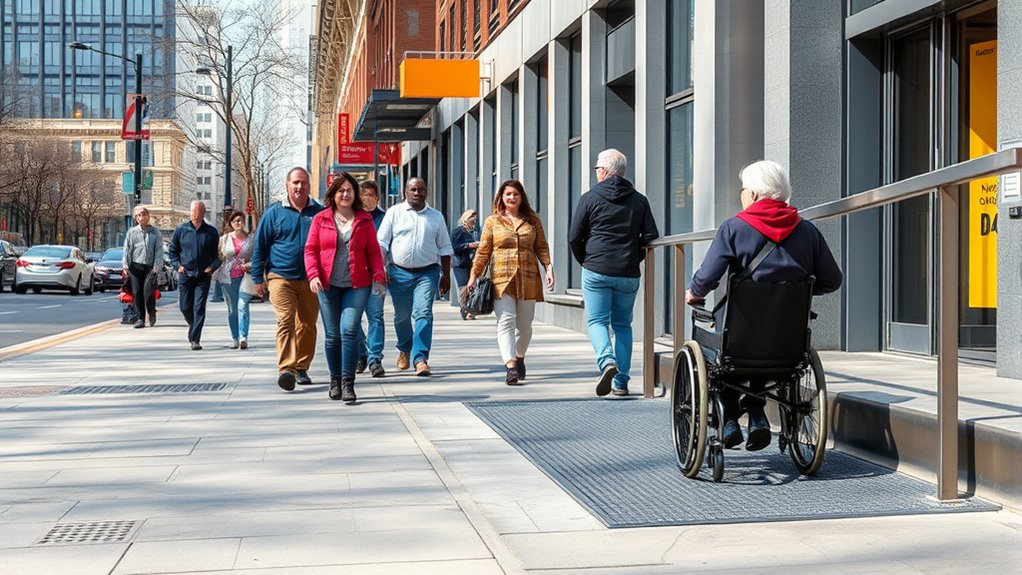In Inclusive Design 101, you can make a big difference with simple tweaks that help millions. Focus on creating accessible spaces by considering diverse needs, adding ramps, tactile paving, and clear signage. Use high-contrast colors and easy-to-understand fonts for better visibility. Incorporate assistive technologies and design environments that support cognitive diversity. Small changes can markedly improve accessibility—if you’re interested, you’ll discover more practical tips to open doors for everyone.
Key Takeaways
- Implement high-contrast, simple signage with icons to enhance visibility and understanding for all users.
- Add tactile paving and ramps alongside stairs to improve mobility access for people with disabilities.
- Use adjustable features like font size and simplified interfaces to support diverse cognitive needs.
- Incorporate assistive technologies such as automated doors and auditory cues for seamless navigation.
- Regularly gather user feedback to identify barriers and refine inclusive design strategies effectively.
Understanding Inclusive Design and Its Benefits
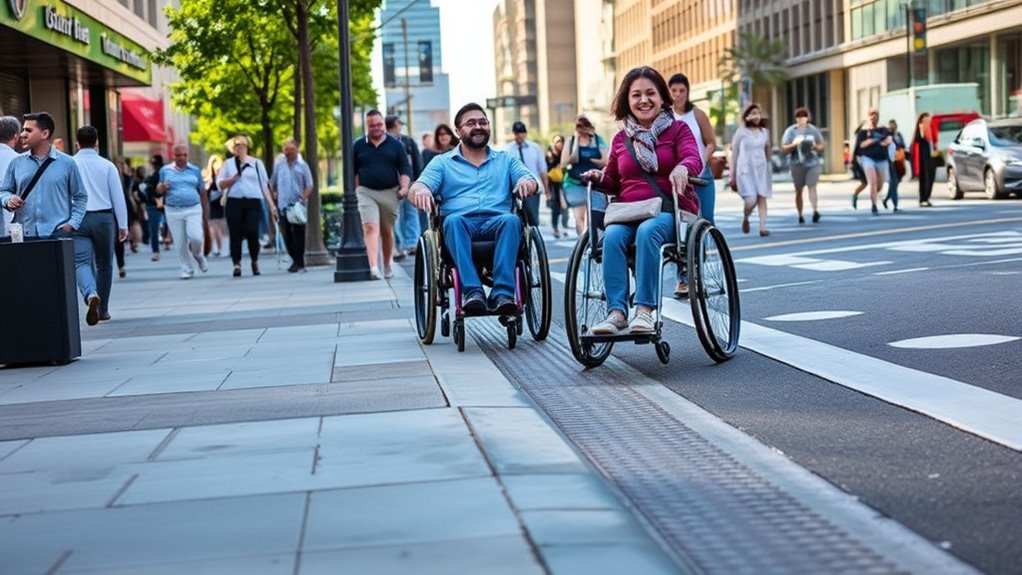
Understanding inclusive design is essential because it creates products and environments that work for everyone, regardless of their abilities or backgrounds. By focusing on adaptive technology, you can develop solutions that accommodate diverse needs, making daily tasks easier for all users. Implementing an inclusive policy within your organization ensures that accessibility becomes a core principle, not an afterthought. This approach benefits everyone by fostering equality, increasing usability, and expanding your reach to a broader audience. Inclusive design isn’t just ethical; it’s practical—enhancing user satisfaction and reducing barriers. When you prioritize these strategies, you create more versatile and welcoming spaces, ultimately contributing to a more inclusive society where everyone has equal opportunities to participate.
Assessing Accessibility in Your Environment
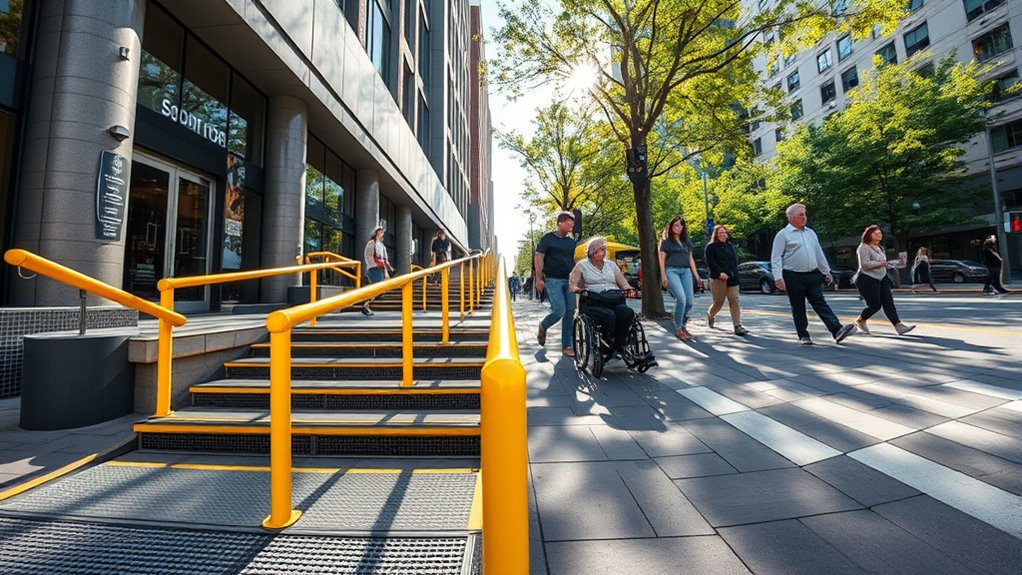
Evaluating accessibility in your environment is a practical step toward creating inclusive spaces. Begin by observing how different individuals experience your environment, paying close attention to sensory accommodations. Are there flashing lights or loud noises that could overwhelm someone with sensory sensitivities? Consider how assistive technology can enhance accessibility, such as screen readers or hearing devices. Check if pathways are wide enough for mobility aids and if signage is clear and easy to read. Engage with users who have diverse needs to gather insights about barriers they face. Regularly reassess your environment, updating features to better support all users. Incorporating disability-friendly features can make a significant difference in fostering an inclusive atmosphere. This proactive approach guarantees your space remains welcoming and accessible, making a tangible difference in opening doors for everyone.
Simplifying Navigation for All Users

Making navigation straightforward for all users involves designing pathways and signage that are intuitive and easy to follow. You can simplify user experiences by integrating gesture controls, allowing users to navigate systems with natural movements. This reduces reliance on complex menus and enhances accessibility for those with motor challenges. Auditory cues also play a essential role by providing clear, spoken instructions or alerts, helping users understand their location or next steps without needing to read text. Combining gesture controls with auditory cues creates a seamless, inclusive environment where everyone can move through spaces or digital interfaces confidently. Implementing accessibility features such as voice command integration further supports diverse user needs. By focusing on these simple yet effective tools, you make navigation more accessible, ensuring that everyone, regardless of ability, can find their way easily.
Incorporating Universal Design Principles

You can make your design more inclusive by using flexible elements that adapt to different needs and preferences. Clear communication strategies guarantee everyone understands your message, regardless of their abilities. Incorporating these universal principles helps create a more accessible experience for all users. Additionally, considering diverse ability levels ensures your design accommodates a wider audience.
Flexible Design Elements
Flexible design elements are essential for creating inclusive spaces that accommodate diverse needs. In adaptive classrooms, you can easily reconfigure layouts to support different learning styles and activities, ensuring everyone feels comfortable and engaged. Incorporating ergonomic furniture helps prevent discomfort and injury, making spaces more accessible for all users. Adjustable desks, chairs, and tables allow individuals to customize their environment, promoting better posture and focus. By prioritizing versatile elements, you create a space that adapts to changing needs over time. This approach not only benefits people with specific requirements but also enhances overall usability. When you embed flexibility into your design, you’re taking a meaningful step toward vibrational alignment, ensuring that your environment welcomes everyone, regardless of their abilities or preferences.
Clear Communication Strategies
Clear communication is essential for creating inclusive spaces that everyone can navigate easily. To achieve this, use a variety of methods, such as incorporating auditory cues like chimes or spoken alerts, which help those with hearing impairments. Including sign language options, whether through videos or live interpreters, ensures that deaf individuals can access information clearly. Keep messages simple, direct, and easy to understand, avoiding jargon or complex language. Visual aids and clear signage also support comprehension. When designing communication strategies, remember to take into account the diverse needs of your audience, ensuring that information is accessible through multiple channels. These simple tweaks foster a welcoming environment where everyone feels informed and included, regardless of their abilities. Additionally, integrating AI-powered accessibility tools can further enhance communication effectiveness and reach a broader audience.
Choosing Inclusive Colors and Fonts
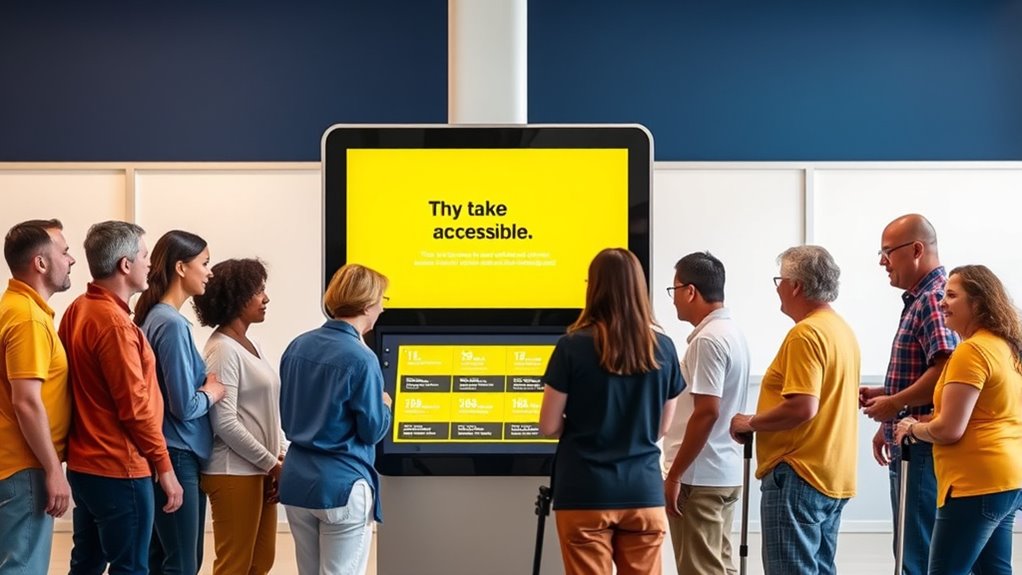
Selecting inclusive colors and fonts is essential for ensuring your design is accessible to everyone. Focus on color contrast to make sure text stands out against its background, helping users with visual impairments or color blindness easily read your content. Avoid pairing colors that are too similar, such as light gray on white, which can cause strain or confusion. When choosing fonts, prioritize readability by selecting clear, simple typefaces without excessive decorative elements. Keep font size large enough for comfortable reading, especially on small screens. Use sufficient spacing between lines and characters to improve clarity. Remember, your goal is to create a visual experience that’s easy to perceive and interpret, making your design welcoming and usable for all users. Incorporating inclusive design principles can further enhance accessibility and ensure your content reaches a broader audience.
Enhancing Physical Accessibility Features
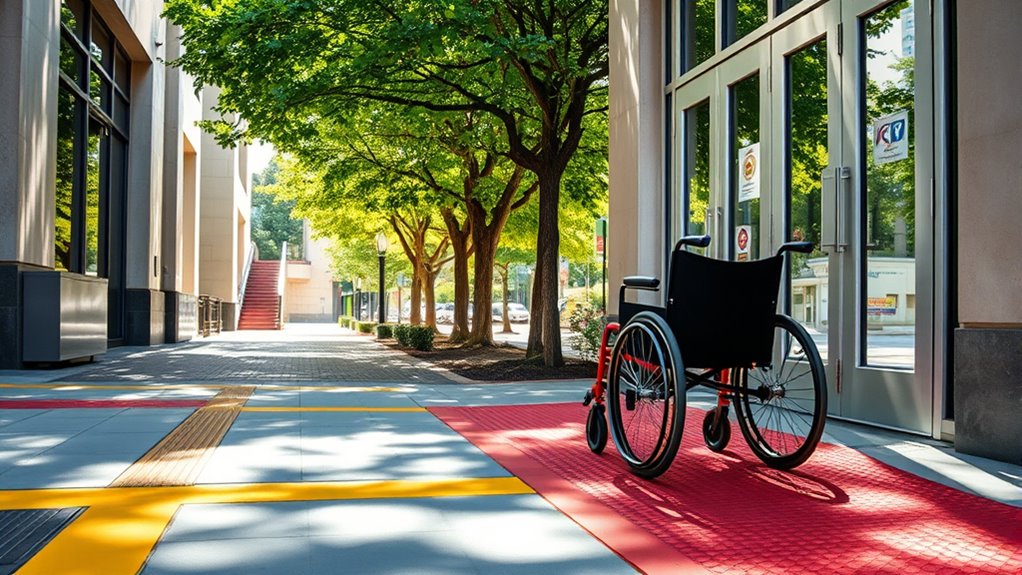
To make your environment more accessible, focus on enhancing physical features that accommodate all users. Incorporate assistive technology, such as automated doors or adjustable counters, to support mobility and independence. Ensure pathways are wide enough for wheelchairs and mobility devices, and add tactile paving to guide visually impaired individuals safely through spaces. Tactile paving provides textured surfaces that alert users to changes in terrain, crossings, or hazards. Smooth, slip-resistant flooring also reduces fall risks for everyone. Install ramps with gentle slopes alongside stairs, and include handrails where needed. Clear signage with contrasting colors improves visibility. Additionally, understanding the importance of vehicle modifications can help create adaptable environments that serve diverse needs. These simple physical enhancements create an inclusive environment, empowering individuals with diverse mobility and sensory needs to navigate confidently and comfortably.
Designing for Cognitive Diversity

Designing for cognitive diversity involves creating environments that support a wide range of mental processes, attention spans, and learning styles. You can achieve this by incorporating adaptive tools that adjust to individual needs, reducing cognitive load and making information easier to process. For example, offering adjustable font sizes, simplified interfaces, or customizable content helps users focus without feeling overwhelmed. It is crucial to recognize that everyone’s brain works differently, so providing multiple ways to access and understand information ensures inclusivity. Minimizing unnecessary distractions and breaking complex tasks into manageable steps can also support diverse cognitive needs. Additionally, understanding Ethical Hacking methodologies can inspire more secure and resilient design practices to protect user data and privacy. By thoughtfully designing with these principles, you make your environment more accessible and welcoming for everyone, regardless of how they think or learn.
Gathering Feedback From Diverse Users
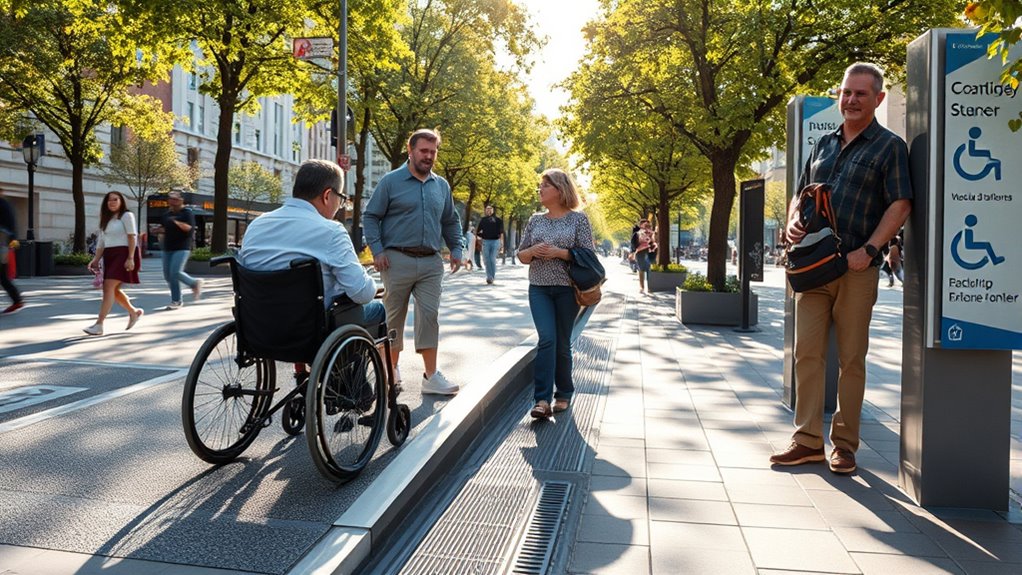
Gathering feedback from diverse users is essential for creating truly inclusive designs. By establishing continuous feedback loops, you guarantee that different perspectives shape your product. User diversity means considering varied abilities, backgrounds, and experiences to identify barriers and opportunities. When you actively seek input from a broad range of users, you uncover insights that might otherwise be overlooked. This process helps you refine your design to better serve everyone, not just a select group. Regularly engaging with diverse users keeps your feedback loops dynamic and effective, fostering improvements rooted in real needs. Incorporating considerations like cost and budgeting ensures that your inclusive design is also practical and sustainable. Remember, inclusive design isn’t a one-time effort—it evolves through ongoing dialogue and adaptation based on genuine user input.
Implementing Small Changes for Big Impact

You can make a big difference by choosing universal colors that everyone can see and understand easily. Clear communication strategies help guarantee your message reaches all users, regardless of their abilities. Small adjustments like these can substantially improve accessibility and inclusivity in your design. Additionally, embracing mindful decluttering principles can help ensure your space remains organized and welcoming for all users.
Universal Color Choices
Choosing universal colors can greatly improve accessibility and guarantee your designs resonate with a broader audience. When selecting colors, prioritize strong color contrast to ensure text and elements stand out clearly for all users, including those with visual impairments. Consistent use of colors fosters visual harmony, making your design more intuitive and comfortable to navigate. Avoid overly bright or clashing hues that can cause confusion or discomfort. Instead, opt for a balanced palette that emphasizes clarity without sacrificing aesthetic appeal. Remember, simple color choices can make a significant difference in how accessible your content feels. By focusing on universal color choices, you create an inclusive experience that welcomes everyone, regardless of their visual abilities. Small adjustments like these can lead to big impacts.
Clear Communication Strategies
Implementing small changes in your communication methods can lead to significant improvements in how your message is received and understood. Focus on signage clarity by using simple, large fonts and high-contrast colors, making signs easy to read at a glance. Incorporate clear icons alongside text to reinforce messages visually. Don’t forget auditory cues—use clear, well-timed sounds or verbal prompts to support those with visual impairments or reading difficulties. Ensure that auditory signals are distinct and not overwhelming. These small adjustments can make your communication more accessible, helping everyone navigate spaces more confidently. When you prioritize clarity and consistency, you create an environment where all individuals feel informed and included, reducing confusion and promoting independence.
Frequently Asked Questions
How Do Cultural Differences Influence Inclusive Design Choices?
Cultural differences considerably influence inclusive design choices because cultural nuances shape how people perceive and interact with products. By understanding these nuances, you can adapt your design to better meet diverse needs. Focus on cultural context and preferences, ensuring your design adapts accordingly. This approach fosters accessibility and acceptance, making your solutions more effective across different communities. Embracing cultural diversity leads to more inclusive, universally usable designs that truly serve everyone.
What Are Common Misconceptions About Accessibility and Inclusion?
Oh, you think accessibility and inclusion are just about making things look pretty? Think again! Many believe assistive technology and inclusive design are separate worlds, fueling stereotypes that only certain people need help. In reality, inclusive design benefits everyone, breaking down those harmful design stereotypes. Misconceptions blind us to the true power of inclusive choices, which open doors for millions—no magic required, just thoughtful tweaks.
How Can Small Businesses Afford Inclusive Design Improvements?
You might wonder how small businesses can afford inclusive design improvements. By focusing on affordability strategies, you can implement budget-friendly upgrades that make a difference without breaking the bank. Simple adjustments like adding ramps, clear signage, or adjustable furniture can enhance accessibility. Prioritizing cost-effective solutions guarantees inclusivity is achievable, helping you serve more customers and demonstrate your commitment to diversity—all while staying within your budget.
What Role Does Technology Play in Advancing Inclusive Environments?
Technology plays a crucial role in advancing inclusive environments by enabling digital accessibility and providing assistive tech tools. You can incorporate screen readers, voice commands, and adjustable interfaces to make digital content accessible to everyone. These innovations help remove barriers for people with disabilities, ensuring equal access and participation. By embracing assistive tech, you create more inclusive spaces, fostering diversity and improving experiences for all users.
How Can Designers Measure the Success of Inclusive Initiatives?
Think of measuring success like checking the gauges on a dashboard. You can assess your inclusive initiatives by analyzing user experience feedback, observing how diverse users interact with your design, and tracking design metrics such as engagement and accessibility improvements. Regularly gather data, listen to user stories, and adjust accordingly. This way, you’ll see if your efforts truly open doors or need refining, ensuring your design serves everyone better.
Conclusion
By embracing inclusive design, you open doors and create connections for countless users. Small, simple tweaks transform spaces, making them more accessible, adaptable, and inviting. When you prioritize perception, prioritize people, and prioritize progress, you pave the way for a more welcoming world. So, start small, stay sincere, and see how your thoughtful efforts turn into tremendous transformations—because inclusive innovation begins with you. Together, let’s build a better, brighter, and more inclusive future.
